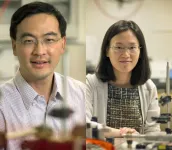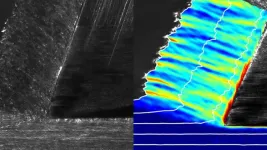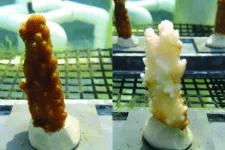(Press-News.org) Investigators from Cedars-Sinai have provided new understanding of how diabetes delays wound healing in the eye, identifying for the first time two related disease-associated changes to the cornea.
The findings, published today in the peer-reviewed journal Diabetologia, also identified three therapeutic pathways that reversed these changes and partially restored wound-healing function to the cornea—a discovery that could ultimately inform new treatments for diabetes.
“We have found that diabetes induces more cellular changes than we were aware of previously,” said Alexander Ljubimov, PhD, director of the Eye Program at Cedars-Sinai’s Board of Governors Regenerative Medicine Institute and senior author of the paper. “The discovery does not affect gene sequence but entails specific DNA modifications altering gene expression—what are known as epigenetic alterations.”
More than 37 million people in the United States—11% of the population—have diabetes, a systemic disorder that can result in kidney disease, heart disease, amputation, stroke and nerve damage. Most diabetes drugs are designed to increase glucose tolerance or supply depleted insulin, but do not address molecular and cellular changes or their associated complications.
The new research also identifies for the first time an important role of Wnt-5a, a secreted signaling protein investigators found responsible for corneal wound healing and the function of stem cells—cells capable of differentiating into many cell types.
“Current treatments only address symptoms, so there is an urgent need to understand the molecular mechanisms of diabetes-related wound-healing problems,” said Ruchi Shah, PhD, a scientist in Ljubimov’s lab and the study’s first author. “Understanding of this novel epigenetically regulated wound-healing mechanism could lead to therapeutic treatments that could help patients avoid further long-term ocular health issues.”
Though much focus of diabetic eye disease is on the retina, up to 70% of diabetes patients suffer from problems of the cornea, the transparent, protective exterior surface of the eye. In advanced diabetes, corneal stem cells become dysfunctional, and the cornea heals more slowly and less completely following an injury or procedures such as cataract surgery and laser treatment for diabetic retinopathy.
To identify the epigenetic changes discovered in this study—changes not hard-wired into the genome from birth, but introduced later—Ljubimov and his team compared cells from the corneas from six diabetic patients with those of five healthy donors. They found that in diabetic corneas, the protein product of the WNT5A gene was repressed. Additionally, in diabetic samples, they found an increase in the microRNA that inhibits WNT5A.
The team of scientists then induced wounds to corneal cells in culture and corneal organ cultures, and tested three interventions designed to normalize Wnt-5a protein expression. They added the Wnt-5a protein directly; they introduced a DNA methylation inhibitor, originally approved to treat cancer; and they targeted microRNA levels with a novel gene therapy approach using a nanoscale compound. The team developed the compound, which uses synthetic molecules to block the microRNA, as a substitute for a viral gene therapy they found to be toxic to stem cells.
All three therapeutic methods, in the diabetic samples, stimulated stem cell marker production and improved tissue regeneration, accelerating wound healing.
“Novel therapies to reverse epigenetic effects could improve corneal function, and may also prove significant in other diabetic complications,” said Clive Svendsen, PhD, director of the Board of Governors Regenerative Medicine Institute and study co-author. “This work certainly helps move the field forward.”
Investigators will continue to analyze their data to better understand the mechanisms of WNT5A and other genes related to wound healing. They are also studying a combination therapy to target both microRNA and DNA methylation in hopes that it will more thoroughly normalize wound healing by increasing Wnt-5a protein.
“Our goal is to develop topical, sustained-release drugs for corneal wound healing,” said Ljubimov. “Drugs that are FDA [Food and Drug Administration] approved and could be easily applied may be one of the most promising approaches for effective future therapies.”
Funding: This work was funded by National Institutes of Health grant numbers R01EY013431482, R01EY031377, R01EY025377, and R01CA206220; and the Cedars-Sinai Board of Governors Regenerative Medicine Institute.
END
Study identifies how diabetes slows healing in the eye
Cedars-Sinai research is first to uncover disease-related changes to the cornea and propose potential therapeutic approaches to correct diabetic wound healing
2023-07-19
ELSE PRESS RELEASES FROM THIS DATE:
Plenary closeup: Biomolecular condensates the foundation for innovations to come
2023-07-19
Biomolecular condensates, the tiny combinations of proteins and mRNA forming membrane-less compartments within cells, have big potential implications for the future of not just plants but humans. On Sunday, August 6, at 9:00 am, the #PlantBio2023 plenary “Highlights of New and Emerging Research on Biomolecular Condensates in Plants” will dive into this new field and its recent discoveries.
“It’s going to be a great way to get your feet wet and understand what biomolecular condensates are,” ...
New Black baby equity clinic helps infants and moms flourish
2023-07-19
Not being heard, not being taken seriously and being misunderstood by health care providers often describes a routine medical visit for many Black parents. For Black parents of young children, that lack of cultural understanding can lead to grim consequences for the health of the baby and mother.
According to the California Department of Public Health, Black babies in the Bay Area are two to three times more likely to be born too soon or too small or to die before their first birthday, compared to white babies. Scientific evidence points to structural racism and a systemic lack ...
Dual wavelengths of light effective against antibiotic-resistant bacterium
2023-07-19
Scientists have combined two light wavelengths to deactivate a bacterium that is invulnerable to some of the world’s most widely used antibiotics, giving hope that the regime could be adapted as a potential disinfectant treatment.
Under the guidance of project leader Dr Gale Brightwell, scientists at New Zealand’s AgResearch demonstrated the novel antimicrobial efficiency of a combination of two light wavelengths against a ‘superbug’ known as antibiotic-resistant extended-spectrum beta-lactamase E. coli.
Antimicrobial resistance (AMR) is a major global threat of ...
Learning from superheroes and AI: UW researchers study how a chatbot can teach kids supportive self-talk
2023-07-19
At first, some parents were wary: An audio chatbot was supposed to teach their kids to speak positively to themselves through lessons about a superhero named Zip. In a world of Siri and Alexa, many people are skeptical that the makers of such technologies are putting children’s welfare first.
Researchers at the University of Washington created a new web app aimed to help children develop skills like self-awareness and emotional management. In Self-Talk with Superhero Zip, a chatbot guided pairs of siblings ...
Consortium explores energy-efficient electronics and photonics
2023-07-19
The University of Texas at Arlington is part of a new consortium funded by the Department of Energy that involves the development of new technologies and college courses covering everything from radiation detection to nuclear engineering.
The grant also will help UTA develop 2D materials that can be integrated into new hand-held photonic technologies with multiple uses.
Electrical Engineering Professor Weidong Zhou and Associate Professor Alice Sun will use the five-year, $1.8 million grant to work with collaborators at UT Arlington, University of North Texas, University of Arkansas Pine Bluff, ...
Staying sharp: Researchers turn to an everyday shop tool to study how materials behave
2023-07-19
Researchers at Texas A&M University are taking a traditional manufacturing tool — metal cutting — and developing a more accessible method for understanding the behavior of metals under extreme conditions.
Metal cutting – scraping a thin layer of material from a metal’s surface using a sharp knife (not unlike how we scrape butter) – might not be the first thing that comes to mind for studying material properties. However, Drs. Dinakar Sagapuram and Hrayer Aprahamian, assistant professors ...
Bipolar disorder linked to 6-fold heightened risk of early death from external causes
2023-07-19
People with bipolar disorder—characterised by extreme mood swings—are 6 times more likely to die before their time from external causes, such as accidents, violence, and suicide, than those without the condition, finds research published in the open access journal BMJ Mental Health.
And they are twice as likely to die from somatic (physical) causes, with alcohol a major contributing factor, the findings show.
A heightened risk of an early death from any cause has been consistently reported in those with ...
Tripling in proportion of smokers’ duty free tobacco purchases in England since 2019
2023-07-19
The proportion of smokers’ duty free tobacco purchases in England has tripled since 2019, rising from just over 5% to just over 16%, but there’s been no reported change in black market purchases, reveals a time-trends analysis published online in the journal Tobacco Control.
Between 2002 and 2014, between 12% and 20% of UK adult smokers said their last tobacco purchase had been from a low or untaxed source. And smokers who buy their tobacco from low/untaxed sources—and those who switch to cheaper products—are less likely to try to quit smoking than those ...
Explore psilocybin and other psychedelics for women’s cancer distress, urge doctors
2023-07-19
It’s time to stop prevaricating and explore the use of psilocybin—the active ingredient in ‘magic mushrooms’—and other psychedelics to ease the often overwhelming distress faced by women with late stage gynaecological cancers, urge doctors in a commentary published online in the International Journal of Gynecological Cancer.
Conventional ‘gold standard’ psychotherapeutic approaches, such as cognitive behavioural therapy (CBT), take too long to change old habits and require too much stamina, suggest the authors from the University of Texas ...
Some corals may survive climate change without paying a metabolic price
2023-07-19
UNIVERSITY PARK, Pa. — If, as the saying goes, ‘nothing in life is free,’ then corals might pay a price for being resilient to climate change. Indeed, the prevailing belief among scientists has been that corals must suffer reduced growth or other tradeoffs when they partner with symbiotic algae that help them tolerate warmer water. Yet, new research led by Penn State demonstrates that certain corals can have their cake and eat it too, and as a result, these coral-symbiont partnerships may come to dominate ...
LAST 30 PRESS RELEASES:
Duke and Duke-NUS’ joint cross-population research to uncover "East-West" differences in disease and care
Scientists to ‘spy’ on cancer- immune cell interactions using quantum technology breakthrough
Tech savvy users have most digital concerns
Making lighter work of calculating fluid and heat flow
Normalizing blood sugar can halve heart attack risk
Lowering blood sugar cuts heart attack risk in people with prediabetes
Study links genetic variants to risk of blinding eye disease in premature infants
Non-opioid ‘pain sponge’ therapy halts cartilage degeneration and relieves chronic pain
AI can pick up cultural values by mimicking how kids learn
China’s ecological redlines offer fast track to 30 x 30 global conservation goal
Invisible indoor threats: emerging household contaminants and their growing risks to human health
Adding antibody treatment to chemo boosts outcomes for children with rare cancer
Germline pathogenic variants among women without a history of breast cancer
Tanning beds triple melanoma risk, potentially causing broad DNA damage
Unique bond identified as key to viral infection speed
Indoor tanning makes youthful skin much older on a genetic level
Mouse model sheds new light on the causes and potential solutions to human GI problems linked to muscular dystrophy
The Journal of Nuclear Medicine ahead-of-print tip sheet: December 12, 2025
Smarter tools for peering into the microscopic world
Applications open for funding to conduct research in the Kinsey Institute archives
Global measure underestimates the severity of food insecurity
Child survivors of critical illness are missing out on timely follow up care
Risk-based vs annual breast cancer screening / the WISDOM randomized clinical trial
University of Toronto launches Electric Vehicle Innovation Ontario to accelerate advanced EV technologies and build Canada’s innovation advantage
Early relapse predicts poor outcomes in aggressive blood cancer
American College of Lifestyle Medicine applauds two CMS models aligned with lifestyle medicine practice and reimbursement
Clinical trial finds cannabis use not a barrier to quitting nicotine vaping
Supplemental nutrition assistance program policies and food insecurity
Switching immune cells to “night mode” could limit damage after a heart attack, study suggests
URI-based Global RIghts Project report spotlights continued troubling trends in worldwide inhumane treatment
[Press-News.org] Study identifies how diabetes slows healing in the eyeCedars-Sinai research is first to uncover disease-related changes to the cornea and propose potential therapeutic approaches to correct diabetic wound healing





